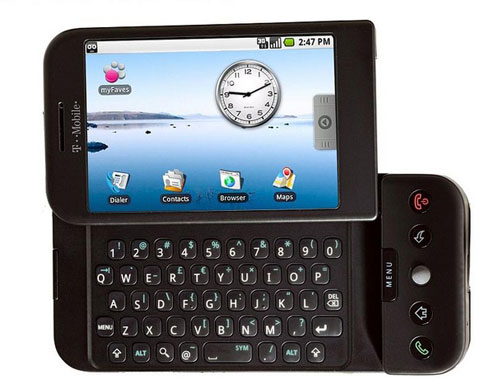The G1 Phone: Do Not Want
Published by marco on
Google has entered the mobile market with the G1, a phone—as described in The G1: Almost perfect (CrunchGear)—for “the programmer and the geek and, in a way, the average consumer”. In a very, very small way. First of all, look at it:
It’s a smart-phone and aimed squarely at the smart-phone market, but don’t even try to mention that the “average consumer” is even conceivably a target market for this monstrosity. It looks huge[1], way bigger than a BlackBerry or an iPhone. With it’s slide-out keyboard and large form factor, it has almost no chance of success in Europe (at least Switzerland), where the iPhone is already considered a bit too large, but still worth it. In the States, it has a better chance, because they seem to like tiny keyboards there and large form-factors aren’t deemed so much of a problem. As a smart-phone, it probably has a chance, as people in that market are willing to sacrifice ease-of-use and a flat learning curve for more features and power. The average consumer, on the other hand, does not want a phone that looks as complex and hard-to-use as a computer.
As for how it stacks up against the iPhone, which is a phone made for the average consumer as well as a direct competitor in the smart-phone market, The T-Grid: T-Mobile’s G1 Android Phone vs. the iPhone (The Technologizer) offers a side-by-side comparison of features and specifications. Notably:
- The G1 will be locked to T-Mobile, in the same way that iPhones are locked to AT&T.
- The G1 has, for whatever reason, a proprietary headphone jack. Not even Apple has their own headphone jack.
- The web browser is “Webkit-based”, so it’s presumably running some variant of the brand-new Google Chrome browser, which is still in beta and has only been available to the public for a few weeks.
- There’s no desktop-syncing because, well, why would you need to sync to the desktop? You’re already synced to the Google Cloud™!
The G1 is, of course, fully integrated into the Google Internet Experience™ with a single signon and quick access to all Google applications. It runs on Google’s very own operating system, Android, which is used officially for the first time. As everyone knows, the first version of an operating system is usually the best, most-polished one, with entropy taking hold and everything going slowly downhill from there. By the third or fourth generation of an OS, it’s nearly unusable, so strike now while the iron is hot.
